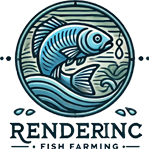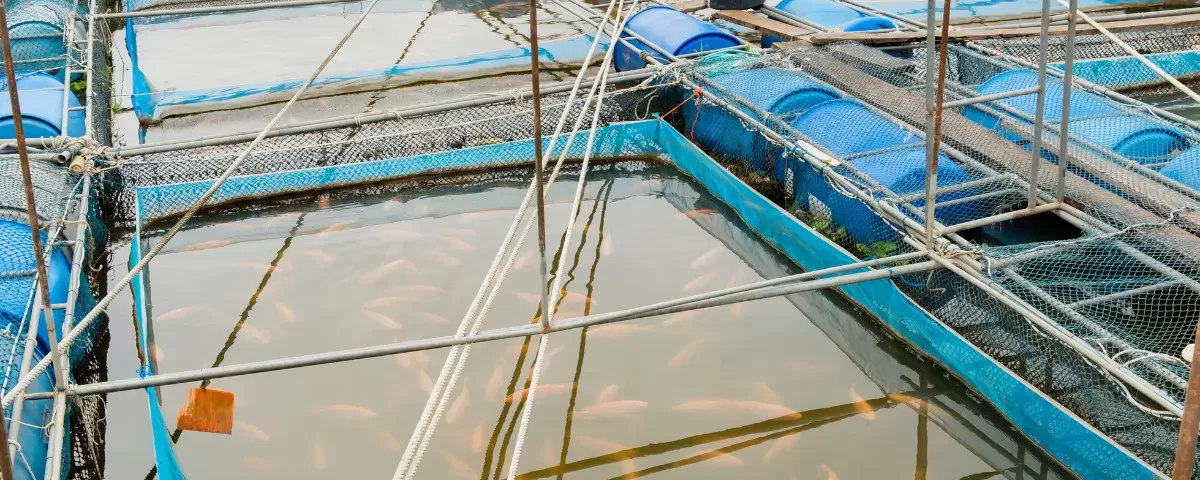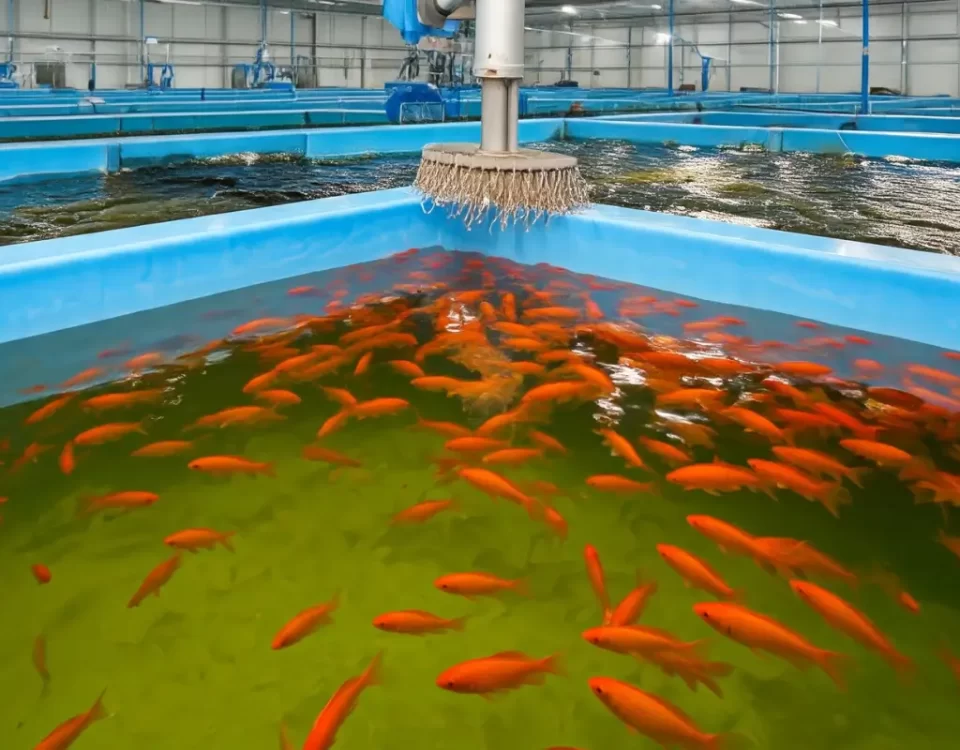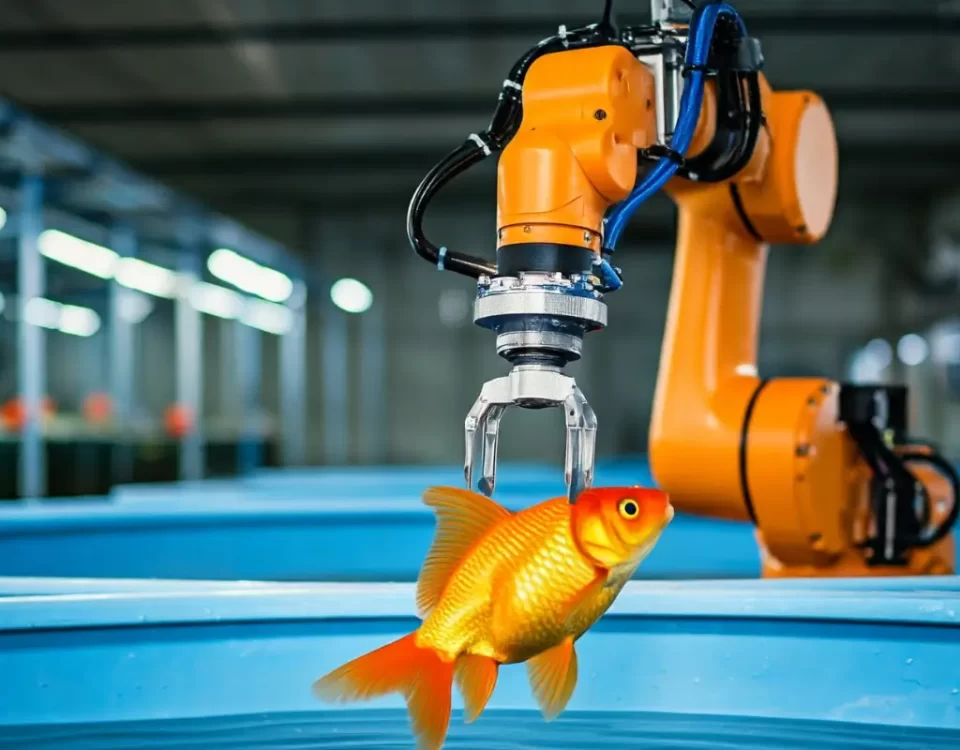Top 5 Game-Changing Technologies in Modern Aquaculture

Fish Farming Techniques: Traditional vs. Modern Methods
setembro 17, 2024
How to Select the Right Fish for Your Aquaculture System
setembro 18, 2024In the realm of modern aquaculture, a realm where the art of fish farming transcends traditional methods, lies a flourishing industry that plays a pivotal role in meeting the surging global demand for seafood. With the world’s population booming and traditional fishing practices reaching their limits, aquaculture emerges as a beacon of hope, offering a sustainable solution that bridges the gap between supply and demand. The cultivation of marine life in controlled environments, be it inland tanks or offshore cages, has become a cornerstone of the seafood market, providing a reliable source of nutrition for millions around the globe.
As the aquaculture industry continues to evolve and expand, technology emerges as a formidable force, driving innovation and reshaping the landscape of fish farming. The integration of cutting-edge technologies has not only increased efficiency and productivity but has also propelled the sector to new heights of sustainability and environmental responsibility. From advanced monitoring systems to precision feeding techniques, technology has become the cornerstone on which modern aquaculture thrives.
Importance of Modern Aquaculture
The importance of modern aquaculture cannot be overstated, especially in the face of depleting wild fish stocks and the escalating demand for seafood. By harnessing the potential of aquaculture, we not only mitigate the pressures on our oceans but also ensure a consistent supply of high-quality protein to nourish our growing population. With sustainability at its core, modern aquaculture offers a viable solution to the challenges posed by overfishing and environmental degradation, paving the way for a more resilient and equitable food system.
Significance of Technology in Aquaculture
Technology serves as the driving force behind the transformation of aquaculture into a high-tech industry that aligns with the needs of the 21st century. Through the adoption of innovative technologies such as automation, artificial intelligence, and IoT devices, fish farmers can optimize their operations, monitor key parameters in real-time, and make data-driven decisions that enhance production efficiency and reduce ecological footprint. The fusion of technology and aquaculture not only ensures economic viability but also sets the stage for a more sustainable and environmentally conscious approach to seafood production.
Automated Feeding Systems
In the realm of modern aquaculture, the integration of automated feeding systems has emerged as a transformative tool in enhancing operational efficiency and promoting sustainability within fish farming practices. These innovative systems have revolutionized the way feed is delivered to aquatic species, yielding remarkable benefits for both producers and the environment.
Impact on Aquaculture Efficiency and Sustainability
Automated feeding systems play a crucial role in streamlining feeding processes by precisely dispensing the optimal amount of feed required by the fish. By eliminating human error and ensuring consistent feeding schedules, these systems contribute to increased efficiency in resource utilization. This precision not only maximizes growth rates and reduces production time but also minimizes the environmental impact of excess feed and nutrient discharge into aquatic ecosystems.
Optimization of Feed Usage and Waste Reduction
One of the most significant advantages of automated feeding systems is their ability to optimize feed usage while minimizing waste. These systems are equipped with sensors and software that monitor fish behavior, environmental conditions, and feed consumption patterns to adjust feeding levels accordingly. By delivering feed in smaller, more frequent doses based on real-time data, they help prevent overfeeding, reduce feed wastage, and maintain water quality.
Enhancement of Fish Health
The implementation of automated feeding technologies has proven to have a profound impact on the health and welfare of farmed fish. By ensuring a consistent and controlled feeding regime, these systems help prevent underfeeding or overfeeding, which can lead to malnutrition or stress-related illnesses. Additionally, some advanced systems are capable of detecting abnormal feeding behavior, allowing early intervention in cases of disease outbreaks or suboptimal feeding conditions.
Innovative Technologies in the Industry
The aquaculture industry has witnessed a surge in the development of cutting-edge automated feeding technologies that cater to the specific needs of different fish species and farming environments. Examples of these innovations include pneumatic feeding systems that deliver feed through air pressure, underwater camera systems that monitor feeding behavior, and automated feeders equipped with smart algorithms for precise feeding. These technologies not only improve feed conversion ratios and reduce labor costs but also pave the way for a more sustainable and efficient future in aquaculture.
Water Quality Monitoring Technologies
Maintaining optimal water quality is paramount in the realm of aquaculture. The well-being and growth of aquatic species heavily rely on a pristine aquatic environment. Factors such as dissolved oxygen levels, pH balance, temperature, and nutrient concentrations must be closely monitored and controlled to prevent stress, disease, or mortality among the farmed fish or shellfish. Any fluctuations in water quality can have detrimental effects on the overall health and productivity of the aquaculture system.
In the past, monitoring water quality in aquaculture operations was a time-consuming and labor-intensive process. However, with the advent of advanced monitoring technologies, such as sensors and real-time data analytics, farmers now have powerful tools at their disposal to swiftly and accurately assess the conditions of their aquatic systems. These sophisticated technologies enable farmers to monitor key parameters continuously and make informed decisions in real-time to maintain an optimal environment for their aquatic species.
Sensors for Precise Monitoring
One of the groundbreaking technologies revolutionizing water quality monitoring in modern aquaculture is the deployment of sensors. These devices can be strategically placed throughout the aquaculture facility to measure crucial parameters like dissolved oxygen, pH, ammonia levels, and temperature. Sensors provide real-time data on water quality conditions, allowing farmers to detect any abnormalities promptly and take corrective actions to safeguard the health of their livestock.
Real-Time Data Analytics for Enhanced Insights
The integration of real-time data analytics software in aquaculture operations has been a game-changer for farmers seeking to optimize water quality management. By analyzing the continuous stream of data collected by sensors, farmers can gain valuable insights into trends and patterns that may affect the aquatic environment. This proactive approach allows for early detection of potential issues and the implementation of proactive measures to maintain optimal water quality conditions.
Transformative Water Quality Monitoring Tools
Several cutting-edge water quality monitoring tools have emerged in recent years, offering innovative solutions to enhance aquaculture practices. For instance, the use of multi-parameter probes that can simultaneously measure various water quality parameters has streamlined monitoring processes and increased efficiency. Additionally, remote monitoring systems equipped with alerts and notifications enable farmers to stay informed about the status of their aquatic systems even when they are off-site, ensuring timely interventions when needed.
In conclusion, the integration of advanced water quality monitoring technologies has revolutionized modern aquaculture practices by providing farmers with the means to maintain a healthy and thriving aquatic environment. These innovative tools not only enhance operational efficiency but also contribute to the sustainability and success of aquaculture ventures. By leveraging the power of sensors, real-time data analytics, and transformative monitoring tools, aquaculturists can uphold the highest standards of water quality management, ultimately leading to optimal growth and productivity of their aquatic species.
Genetics and Breeding Innovations
Genetics and breeding technologies have revolutionized the landscape of modern aquaculture, offering innovative solutions to enhance productivity and resilience in fish farming operations. Through strategic selective breeding programs, aquaculture practitioners can target specific traits in fish species, such as disease resistance and growth rates, to improve overall quality and yield.
Selective Breeding for Desired Traits
Selective breeding plays a pivotal role in aquaculture by favoring certain genetic characteristics in fish populations over successive generations. By carefully choosing breeding pairs with desirable traits, such as enhanced disease resistance or faster growth rates, aquaculturists can accelerate the development of superior fish stocks. This process is not only time-efficient but also results in fish that are better equipped to thrive in aquaculture settings.
Genetic Manipulation Techniques
In addition to traditional selective breeding, aquaculture researchers are exploring genetic manipulation techniques to further advance fish farming capabilities. Through methods like transgenesis and genomic editing, scientists can introduce specific genes or alter existing ones to confer advantageous traits in fish species. These technologies open up possibilities for creating disease-resistant and environmentally adaptable fish varieties that can withstand various challenges in aquaculture environments.
The Promise of Gene Editing Tools
One of the most groundbreaking advancements in genetics and breeding for aquaculture is the emergence of gene editing tools like CRISPR-Cas9. This revolutionary technology allows researchers to precisely modify the genetic makeup of fish species, offering unprecedented control over traits such as growth rates and nutritional profiles. The potential of CRISPR-Cas9 in shaping the future of aquaculture is immense, as it enables the development of tailored fish lines that meet the evolving needs of the industry.
By leveraging genetics and breeding innovations, aquaculture stakeholders can strategically enhance the performance and sustainability of fish farming operations, paving the way for a more efficient and resilient aquaculture sector.
Recirculating Aquaculture Systems (RAS)
In the realm of modern aquaculture, Recirculating Aquaculture Systems (RAS) stand out as a groundbreaking technology revolutionizing fish farming practices. RAS technology involves a closed-loop system where water is continuously recycled and treated within the aquaculture facility, offering a range of benefits that propel sustainable fish farming to new heights.
Sustainable Fish Farming with RAS Technology
One of the primary advantages of implementing RAS technology is its environmentally friendly nature. By enabling the efficient reuse of water, RAS significantly reduces the amount of water needed for fish cultivation compared to traditional open-system aquaculture methods. This water conservation aspect not only promotes sustainability but also helps mitigate water pollution by minimizing the discharge of effluents into natural water bodies.
Efficiency and Environmental Impact Minimization
RAS technology plays a crucial role in minimizing environmental impact associated with fish farming operations. The closed-loop system allows for precise control over water quality parameters such as temperature, oxygen levels, and waste removal, ensuring optimal conditions for fish growth while minimizing the risk of disease outbreaks. Moreover, the ability to recycle and filter water within the system results in reduced wastewater discharge, further contributing to a more eco-conscious approach to aquaculture.
Global Success Stories of RAS Implementations
Across the globe, numerous success stories highlight the transformative potential of RAS technology in the aquaculture industry. For instance, in Norway, a pioneer in sustainable aquaculture practices, RAS systems have been implemented with remarkable success, showcasing significant improvements in fish welfare and production efficiency. Similarly, countries like the United States, Denmark, and Singapore have embraced RAS technology to enhance their aquaculture sector, demonstrating its adaptability and effectiveness across diverse geographic and operational contexts.
Embracing Innovation for a Sustainable Future
As the demand for sustainable seafood continues to rise, the adoption of advanced technologies like RAS is poised to play a pivotal role in shaping the future of aquaculture. By promoting resource efficiency, environmental stewardship, and operational resilience, RAS technology exemplifies the transformative power of innovation in ensuring the long-term viability and sustainability of the global fish farming industry.
AI and Big Data in Aquaculture
In the realm of modern aquaculture, the integration of artificial intelligence (AI) and big data technologies has emerged as a formidable force, revolutionizing the way fish farms are managed and operated. These innovative technologies are not merely avant-garde tools but indispensable allies in the quest for sustainable and efficient aquaculture practices. By harnessing the power of AI and big data analytics, aquaculture professionals can delve deep into the intricate dynamics of their operations with precision and foresight, garnering invaluable insights that foster informed decision-making processes.
Harnessing AI for Feed Formulations
One of the primary applications of AI in aquaculture lies in optimizing feed formulations. By analyzing vast datasets on the nutritional requirements of different fish species, AI-powered algorithms can recommend tailored feed compositions that enhance growth rates, boost immune systems, and minimize environmental impacts. Through continuous learning and adaptation, AI systems can fine-tune feed formulations based on real-time data, ensuring optimal nutrition delivery for healthier fish stocks.
Predicting Disease Outbreaks with Precision
AI technology holds the potential to transform disease management strategies within aquaculture facilities. By leveraging historical health data, environmental parameters, and sophisticated algorithms, AI can forecast disease outbreaks with remarkable accuracy. Early detection of potential health threats enables aquaculturists to swiftly implement preventive measures, mitigating risks and safeguarding the well-being of aquatic populations. This proactive approach not only enhances animal welfare but also averts financial losses associated with disease outbreaks.
Enhancing Farm Performance through Data-driven Insights
The integration of big data analytics in aquaculture empowers farmers to optimize their operations at a granular level. By analyzing a myriad of parameters such as water quality, temperature fluctuations, feed consumption patterns, and growth rates, farm managers can identify trends and patterns that would otherwise elude manual observation. This wealth of data facilitates precise decision-making, enabling farmers to fine-tune their production processes, minimize resource wastage, and maximize efficiency. From improving stocking densities to enhancing stocking schedules, big data plays a pivotal role in elevating farm performance to new heights.
Shaping the Future of Aquaculture
As we traverse further into the digital age, the intersection of AI and big data in aquaculture promises to redefine the industry’s landscape. The fusion of cutting-edge technologies with time-honored aquaculture practices heralds a new era of sustainable farming, characterized by data-driven precision and progressive innovation. By embracing AI applications and harnessing the potential of big data analytics, aquaculturists can navigate complex challenges, optimize resource utilization, and cultivate a thriving ecosystem where productivity harmonizes with environmental stewardship. The future of aquaculture is inexorably intertwined with the transformative capabilities of AI and big data, setting the stage for a paradigm shift in how we nurture and sustain aquatic life.
In the realm of modern aquaculture, technology stands at the forefront of revolutionizing the industry, driving it towards greater efficiency and sustainability. The top 5 game-changing technologies explored in this article have underscored a seismic shift in how fish farming is approached, setting the stage for a more innovative and environmentally conscious future. By leveraging these cutting-edge tools and techniques, aquaculturists can not only boost productivity but also minimize the negative impact on fragile aquatic ecosystems.
Aquaponics, with its symbiotic relationship between fish and plants, has reshaped the way we view aquaculture by introducing a closed-loop system that maximizes resource utilization. This integration of aquaculture and hydroponics offers a holistic approach to seafood production, where waste becomes a valuable resource rather than a burden. Moving forward, embracing aquaponics can lead to a more sustainable and self-sufficient aquaculture industry that prioritizes minimizing its carbon footprint.
IoT devices have emerged as powerful tools in aquaculture management, enabling farmers to monitor crucial parameters such as water quality, oxygen levels, and feeding patterns in real time. By harnessing the data generated by these smart devices, aquafarmers can make informed decisions, optimize operations, and respond promptly to potential issues. The interconnected nature of IoT technology helps to create a more responsive and proactive aquaculture sector, mitigating risks and improving overall production efficiency.
Genetic technologies, including selective breeding and genetic engineering, have propelled aquaculture towards the realm of highly resilient and productive fish stocks. Through targeted breeding programs, fish farmers can develop strains that exhibit desirable traits such as disease resistance, growth rate, and feed conversion efficiency. Moreover, advancements in genetic engineering offer the potential to overcome challenges like limited wild fish stocks and environmental impact, paving the way for tailored and sustainable aquaculture solutions.
Automation and robotics have revolutionized the labor-intensive tasks involved in aquaculture operations, streamlining processes and increasing overall productivity. From automated feeding systems to underwater drones for monitoring fish behavior, these technologies free up human resources while ensuring precision and efficiency in day-to-day operations. Embracing automation not only boosts efficiency but also enhances animal welfare by providing a controlled and optimized environment for aquatic species.
In conclusion, the convergence of these game-changing technologies exemplifies the critical role that innovation plays in shaping the future of modern aquaculture. As we navigate the complexities of seafood production in an ever-changing world, it is imperative for industry stakeholders and consumers alike to stay informed and engaged with the latest advancements in technology. By championing sustainable practices and embracing technological progress, we can collectively support a more resilient, efficient, and eco-conscious aquaculture industry for generations to come.

Michael Rivers is an experienced aquaculture enthusiast with over a decade of hands-on knowledge in fish farming and sustainable aquatic systems. Passionate about promoting eco-friendly practices, he shares his expertise on fish breeding, water management, and the latest advancements in aquaculture technology. Through his blog, Michael aims to help both beginners and seasoned fish farmers achieve success in their ventures while contributing to the growth of sustainable food production.




